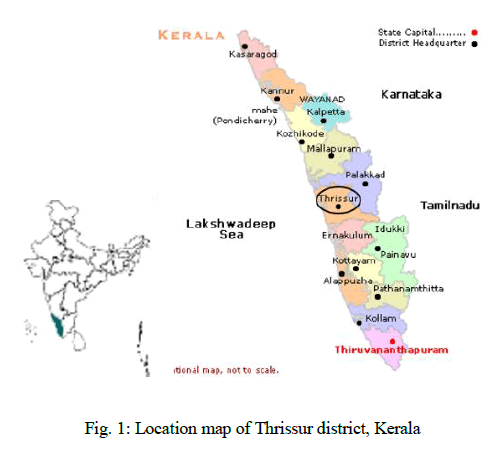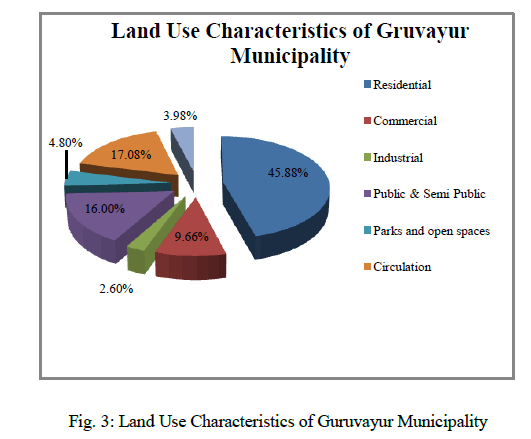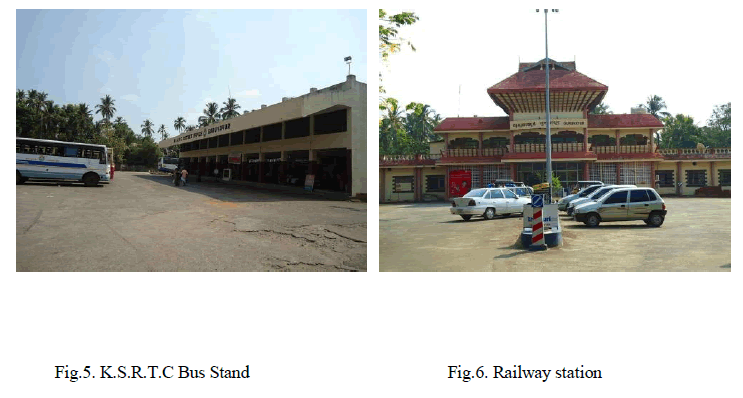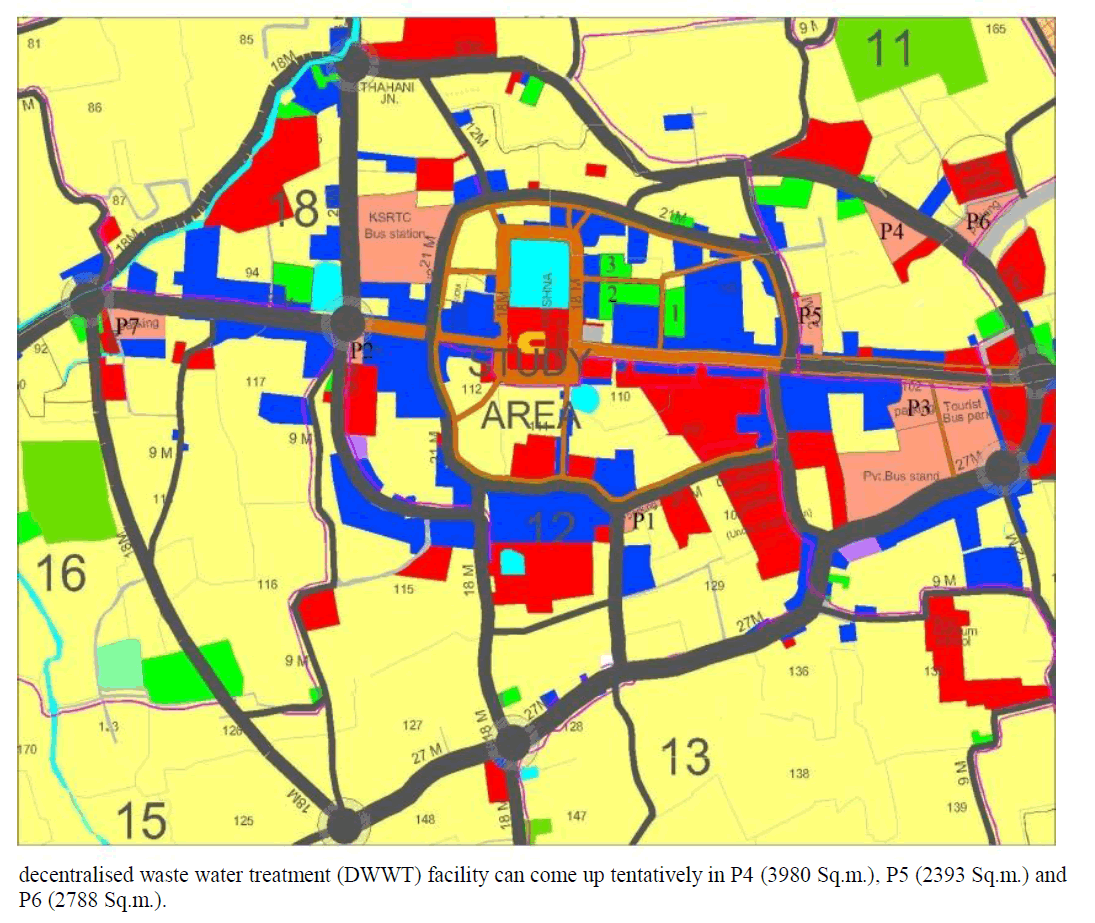ISSN ONLINE(2319-8753)PRINT(2347-6710)
ISSN ONLINE(2319-8753)PRINT(2347-6710)
Govind M.P.1 and Yogesh Keskar2
|
| Related article at Pubmed, Scholar Google |
Visit for more related articles at International Journal of Innovative Research in Science, Engineering and Technology
Guruvayur is a very important pilgrimage centre as well as one of the major south Indian temple attractions. It is also known as the Dwarka of the South. God Krishna in Guruvayur is popularly called Sri Guruvayoorappan. The whole life of this town revolves around the temple and there is very little activity beyond what is connected with the temple even though there are a few other noteworthy temples in the area. Core of activities occur within an area coming within the outer ring road surrounding the temple. Therefore, for the purpose of environmental status assessment, this area has been considered in this study. Under environmental status assessment of Guruvayur temple precincts, Municipal Solid Waste Management, Sewage Management & Storm Water Drainage and Crowd Management are covered, keeping in mind the fragile environment of the temple precincts. The analytic hierarchy process (AHP) has been applied to identify most suitable use for some of the existing parking lots. It is a structured technique for organizing and analysing complex decisions, based on mathematics and psychology.
Keywords |
| Guruvayur temple precinct, Environmental Status Assessment, Analytic Hierarchy Process, Crowd Management, Solid Waste Management, Decentralised Waste Water Treatment |
INTRODUCTION |
| Guruvayur is a Municipal Town situated in Thrissur district in Kerala state in India famous for its Krishna Temple. Guruvayur lies in 100 35âÃâ¬ÃŸ N latitude and 760 00âÃâ¬ÃŸ E longitude with an average elevation of 3.5 M above M.S.L.This temple has been the focal point of Guruvayur Satyagraha (passive resistance) in 1931, resulting in permission for temple entry to dalits to all the temples of Kerala. The Guruvayur DevaswomAct of 1978 describes the Krishna temple as a temple of unique importance which owns extensive properties and endowments in which millions of devotees from all over India are reposing their faith and belief. |
 |
 |
| Fig. 2: Panoramic view of Guruvayur Temple |
EVOLUTION OF GURUVAYUR MUNICIPALITY |
| Till 1956, area consisting of Guruvayur temple was called as Amsom (means region) with partly in Chowghat panchayat and mainly in adjacent Kottappadi panchayat, affecting the planning for development of this area dearly. Demand for separate panchayat for this area hence became very strong and ultimately a township consisting of the temple and its surrounding areas was formed in 1962 and after the enactment of the Kerala Municipality Act, 1994, itwas converted into municipality with refined boundaries. Theland use characteristics of the municipality in year 2008 as percentage break up is shown in figure 3. The land use distribution has been calculated on the basis of the master plan document provided to the author by the Town and Country Planning Department, Thrissur. The first Guruvayur Town development plan was prepared in 1965. Under this plan, many developmental initiatives were implemented within the town such as inner ring road and outer ring road. In 2001, area covered in Guruvayur Municipality was 7.476 Sq.Km and total resident population was 21186. In 2011, the population has risen to 67006 and the existing wards were split again to make them 43 in number. |
 |
ENVIRONMENTAL STATUS ASSESSMENT |
| Core of activities occur within an area coming within the outer ring road surrounding the temple. Therefore, for the purpose of environmental status assessment, this area has been considered in this study. Under environmental status assessment of Guruvayur temple precincts, following key sectors / areas are covered within the ambit of physical environment: |
| • Municipal Solid Waste Management (MSWM) |
| • Sewage Management& Storm Water Drainage |
| • Crowd Management |
Municipal Solid Waste Management |
| As per the Manual on Municipal Solid Waste Management, 2000, municipal solid waste include wastes resulting from municipal activities and services such as street waste, dead animals, market waste and abandoned vehicles etc., the term is commonly applied in a wider sense to incorporate domestic wastes, institutional wastes and commercial wastes. Commercial wastes are solid wastes that originate in offices, whole sale and retail stores, restaurants, hotels, markets, warehouses and other commercial establishments. Some of these are further classified as garbage and others as rubbish. Garbage is the term applied to animal and vegetable wastes resulting from the handling, storage, sale, preparation, cooking and serving of food. Such wastes contain putrescible matter, which produces strong odours and therefore attracts rats, flies and other vermin. It requires immediate attention in its storage, handling and disposal. Rubbish is a general term applied to solid waste originating from households, commercial establishments and institutions, excluding garbage and ashes. Ashes are the residues from the burning of wood, coal, charcoal, coke and other combustible materials, for cooking and heating in houses, institutions and small industrial establishments. |
| This temple has been known to be an auspicious site for conducting marriages leaving behind about 20 MT (2008 estimate) of municipal solid waste. In general, of the municipal solid waste generated in India, about 40% consist of vegetables and leaves. But, here, out of the biodegradable portion of waste, the main constituent is banana leaves, which is used for serving lunch during marriages. On an average day, solid waste generated from temple and precincts consisting of uttupura (community hall), prasadam counters (for selling sweet dishes & banana), nadapanthal (circular walk-way), auditorium (for holding annual music events, special performances etc.), holy tank (temple pond) and uralppurawas 2750 Kg. Total waste generated from other establishments of Devaswom such as administrative office (1365 Kg.) and elephant sanctuary (12090 Kg.) was 13455 Kg. Total number of collection points within the temple precincts was 92, out of which, 83 are managed by Kudumbashree and the remaining 09 by the Guruvayur Municipality. From the pilgrim count of 2005-06 available from Devaswom, the average number of pilgrims coming to temple core in a day is 36,000. Considering 0.45 Kg. of solid waste generation per day per pilgrim, the average possible solid waste generation is 16200 Kg. / day. The total solid waste generated from temple precincts and administrative office (excluding the elephant sanctuary) thus works out to be about 20 MT. |
| Kudumbashree(conceived as a joint programme of the Government of Kerala) and Nabard (National Bank for Agriculture & Rural Development), implement programmes through community development societies (CDCs) of poor women, serving as the community wing of Local Governments. Kudumbashree, formally registered as the „State Poverty Eradication MissionâÃâ¬ÃŸ (SPEM), is a society registered under the Travancore Kochi Literary, Scientific and Charitable Societies Act 1955. It has a governing body chaired by the State Minister of LSG. Grassroots of Kudumbashree are Neighbourhood Groups (NHGs) that send representatives to the ward level Area Development Societies (ADSs). The ADS sends its representatives to Community Development Societies (CDSs), which complete the unique 3-tier structure of Kudumbashree. |
| The municipality owns 1.8 Hectares of land for its waste management schemes located at a distance of 3 Km from the temple. Even after the passage of 6 years from the date of survey conducted by the author, the solid waste management condition remains the same, which ends with open dumping of un-segregated waste at this site.s |
Sewage Management & Storm Water Drainage |
| Most commercial establishments and apartments do not have properly functional septic tanks and discharge the raw sewage directly into open drains [5]. The drains, valiyathod and cheriyathod flow three kilometres through the town before joining the back waters of Chakkamkandam. The discharge of untreated domestic and commercial effluents in to the backwater has resulted in severe environmental problems such as deteriorated waterquality and health and livelihoodrelated issues in the neighbouring villages. The municipality had started constructing a centralised Sewage Treatment Plant (STP) in 1995 at Chakkumkandam usingactivated sludge process (ASP) technology. |
| Because of the undue delay in getting the STP functional, severe environmental damages are still continuing [newspaper report]. A study done by the District Town Planning Department identified following issues related to high-rise commercial establishments within the temple precincts [5]. |
| • Waste water treatment efficiency in buildings generating sullage, mostly restaurants, was lesser than those generating sewage only |
| • Buildings have no adequate system for sludge (generated as a waste product during the operation of waste water treatment plants) dewatering and disposal |
| • Reuse of treated waste water is not practiced |
| Because of the average elevation of this area being 3.35 M above M.S.L, there are higher chances for inundation during heavy rains. Therefore, storm water management assumes great significance. For the purpose of assessing the situation of drainage system, the road stretches of the entire study area have been codified into stretches. The status of drainage system has been accordingly classified. Almost 100% of the entire core area has storm water drains. The storm water drains (side drains) along the main walk way to the temple as well as other alternatepedestrianized routes have been covered with concrete slabs. The issues identified were as follows: |
| (1) Most of the drains are stagnant with silt and garbage thrown in them. |
| (2) Most of these drains pose risks of overflow and flooding in the rainy season. |
| (3) Almost all the storm water drains starting from Satram junction till the temple entrance and from west nada junctiontill the temple entrance are covered but with no proper measures for periodic cleaning and silt removal. |
| (4) Insanitary conditions are created by these storm water drains due to discharge of hotel waste and wastes from shops, and the flow being stagnant poses severe sanitation problems and health risks. |
Findings of the Primary Survey |
| Based on recent visits and newspaper reports, the existing condition of Municipal Solid Waste Management (MSWM), storm water drainage and sewage management is found to be the same as it was in 2008. Therefore, the primary survey results of 2008 are taken as relevant even today. As part of the study done in 2008, the author had conducted a primary survey of 50 pilgrims to understand their perception on the physical environment of temple precincts. The outcome of |
 |
 |
Crowd Management |
| From the data procured from Devaswom, it can be observed that, from mid July 2005 to mid-July 2006, maximum number of pilgrims was received in December (1691236 souls) and the least in February (814465 souls). From the data, during special days, maximum number of pilgrims was received during “Ekadashi” in the month of December (1,33,331 souls). |
| Study of pressure of pilgrims on the physical environment of the temple premises has been attempted here. Guruvayur temple is considered as an auspicious venue for the conduct of marriages. The months during which, maximum of marriages in a year take place are from August to October. After the main event of exchange of flower garlands between the bride groom and the bride, the invitees and family members from both sides proceed for lunch, which typically happen in a hotel. There are 16 hotels within 1 Km distance around the temple; around 15-20 marriages take place in a hotel in a month during these three months. Assuming 1000 persons per marriage; in a month, 240000- 320000 people are present within the 1 Km distance of the temple. As per the study done by Town Planning department, Thrissur, of the persons coming here for attending marriage, 70% visit the temple, which means 168000-224000 people in a month. From the data procured from Devaswom, the average monthly arrival of pilgrims from August-October is 877513. Therefore, 20-25% of this figure is contributed by the marriage crowd. |
| Now calculating, how many people can be accommodated in the temple precincts for the Darsan on the peak day: |
 |
| Average number of pilgrims having Darshan in a day during the marriage season(August – October) is equal to 29250 (877513/30). On a normal day, temple is open for Darshanfor 15 hrs. (10 hrs. in the morning (3.00 A.M to 1.00 P.M) and 5 hrs. from the evening till night (4.00 P.M to 9.00 P.M)) Assuming that the average number of pilgrims on a day during marriage season is spread across 15 hrs, the number of pilgrims per hour comes out to be 1950. Therefore, the number of pilgrims per hour occupying 23Sq.m. area within the temple precincts is 1 (one).As perAmerican Association of State Highway and Transportation Officials (AASHTO) standards, for standing and free circulation through the queuing area without disturbing others within the queue, the space per person should be > 1.2Sq.m. Therefore, the available space within the precincts is more than sufficient. |
Analytic Hierarchy Process (AHP) for identifying the most suitable use for existing parking lots: |
| Analytic Hierarchy Process (AHP) [6] is attempted to identify the most suitable use for the existing parking lots within the temple precincts. The standard scale of comparison as given in table 1 is used for pair-wise comparison of criteria and alternatives to arrive at the relative priorities. |
 |
| Criteria: (C1) Vehicles to be prevented entry into the central core (C2) unsegregated solid waste and possibility of its segregation (C3) Improper treatment of waste water generated from hotels and guesthouses and possibility of its treatment |
| Alternatives: (A1) parking space for vehicles during peak marriage season (A2) decentralised waste water treatment facility (A3) dry waste segregation facility. In step 1 of the AHP, the pair-wise comparison of alternatives vis-a-vis the criteria is done and the relative priorities of alternatives for each of the criterion is measured. In step 2, criteria are compared vis-a-vis the goal, which is to identify the most suitable use for the existing parking lots within the temple precincts. The end result of step 2 is the relative priorities of criteria vis-a-vis the goal. In stpe-3, final priorities are synthesised and the alternative scoring highest total score across all the criteria is considered for the given land parcel. This process has been repeated for all the present parking lots numbered on the map as P1, P2, P3, P4, P5, P6 and P7. |
 |
| After applying AHP for all the parking lots, it has been concluded that P1 (713 Sq.m), P2 (741 Sq.m), P3 (3115 Sq.m) & P7 (2509 Sq.m) can be used only for parking (parking got higher priority than other two alternatives). A multi-level parking facility may be thought of in case of P3 and P7.In case of remaining three lots (P4,P5 and P6), alternative 2&3 have equal priority but higher value than alternative 1. Therefore, both dry waste segregation facility (DWSF) and |
 |
CONCLUSION |
| Waste water generated from commercial land uses could be treated through [7] baffledreactorpreceded by septic tank. Both are methods of decentralised waste water treatment consisting of primary and secondary stages of treatment. Septic tank is part of primary stage, where the treatment is sedimentation and sludge stabilisation. The advantages of septic tank are (1) simplicity (2) Easy to construct (3) little space requirement because of under-ground construction and (4) durability. The disadvantages of septic tank are (1) low treatment efficiency and (2) effluent with odour. In order to circumvent these draw backs, the effluent could be sent to baffled reactor under secondary stage. Here, the treatment is anaerobic degradation of suspended and dissolved solids. The advantages and disadvantages of baffled reactor are as follows: Advantages – (1) simplicity (2) durability (3) high treatment efficiency (4) less permanent space requirement because of underground construction. Disadvantages – (1) longer start-up phase than anaerobic filter (another anaerobic treatment method). |
| For better management of municipal solid waste management, door-to-door segregation from commercial establishments is to be followed. The segregated recyclable waste can be sold from the dry waste segregation facilities to be set up in parking lots (P4, P5 and P6) after further segregation. The biodegradable waste shall be transported to the existing dump site (3 km away) for composting using windrow composting technology. The rejects from the compost plant and DWSF should be land filled in a Sanitary Landfill located within the dump site itself. All of the proposals mentioned above are being suggestedkeeping in mind the fragile environment of the temple precincts. |
ACKNOWLEDGEMENT |
| The authors expresses their humble gratitude to Mr.Gopakumar, Dy.Town Planner, Thrissur district for providing the Master Plan of Guruvayur, Integrated District Development Plan of Thrissur and for general discussion. Thanks are also to Prof.Binayak Choudhury, H.O.D (Planning), School of Planning & Architecture, Bhopal and Prof. Shovan K.Saha, Former Director, School of Planning & Architecture, Vijayawada for their guidance for this paper. |
References |
|